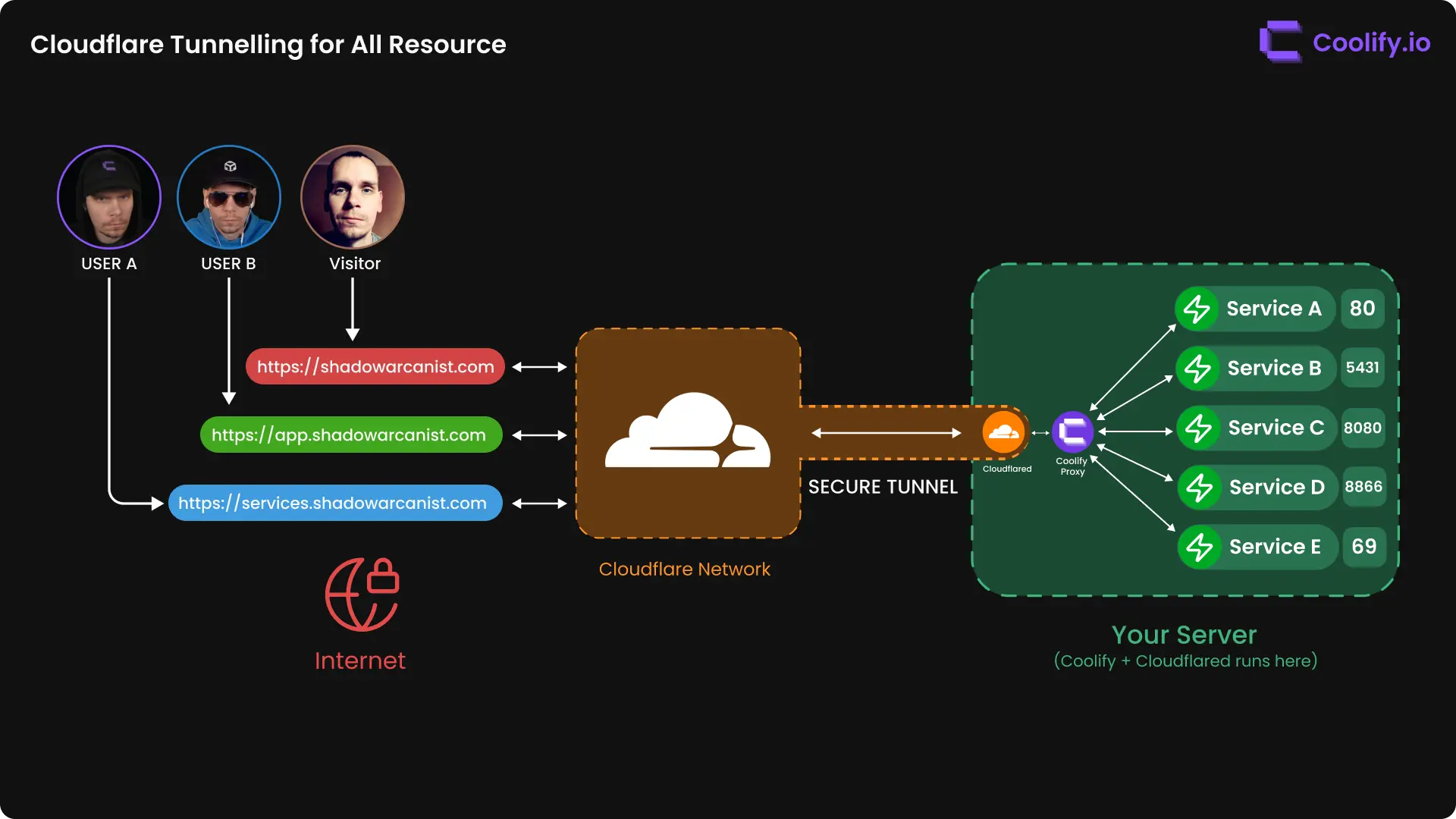Access All Resource via Cloudflare Tunnels
Accessing All Resource deployed on Coolify using a Cloudflare Tunnel allows you to securely reach your app without exposing your server’s IP address or without having a Public IP address for the server.
Who this is for?
This setup is ideal for people who:
- Don't have a public IP for their server (could be a laptop, rasberry pi etc..).
- Are unable to port forward (e.g., using home internet or on a private network).
- Want to keep their server’s IP address private and avoid exposing it to the public internet.
- Have an resource already deployed on Coolify and need an external method to access it securely.
Setup Requirements
To follow this guide, you'll need:
- A free Cloudflare account.
- You need a domain that has it's DNS managed by Cloudflare.
Before We Start
- We assume you have Coolify running on your server.
- If your app requires HTTPS for functionality like cookies or login, then you need to follow the Full TLS HTTPS guide after following this guide. This is because in this guide, Cloudflare will manage HTTPS externally, while your app will run over HTTP within Coolify.
How It Works?
A simple high-level overview diagram to give you a visual idea of how this works:

Quick Links to Important Sections:
- Create a Cloudflare Tunnel
- Setup Encryption mode on Cloudflare
- Setup Cloudflare Tunnel on Coolify
- Start Coolify Proxy
- Configure Your Resource to Use the Tunnel Domain
- How to use Mutiple Different Domains
- Known issues and Solutions
Example Data
The following data is used as an example in this guide. Please replace it with your actual data when following the steps:
- Domain Name: shadowarcanist.com
1. Create a Cloudflare Tunnel
To create a Cloudflare Tunnel, first log in to your Cloudflare account and go to the Zero Trust page.

- On the Zero Trust page, go to Networks in the sidebar.
- Click on Tunnels
- Click on Add a tunnel button
You will be prompted to choose a tunnel type. Click the Select Cloudflared button.

You will be prompted to enter a tunnel name. Choose a name that you prefer.

Next you will see the configuration page with multiple options to install cloudflared.

Copy the install command, which contains the token for your tunnel (token starts with "eyJ"). Make sure to save only the token, removing the command part before it, and store it in a safe place, as we need it later.

Scroll down until you see the Next button, then click it.
Then, you will be prompted to add a hostname.

- Subdomain - (Optional) You can make your all of your resource accessible on any subdomain/domain. For this guide, we are using a wildcard subdomain.
- Domain - Choose the domain you want to use for the tunnel.
- Path - Leave this field empty.
- Type - Choose HTTP (this is very important).
- URL - Enter localhost:80 (this is very important).
- After filling in the details, click the Save Tunnel button.
2. Setup Encryption mode on Cloudflare
To set up encryption on Cloudflare, follow these steps:

- Go to SSL/TLS in Cloudflare.
- Select Overview.
- Click Configure button

Choose Full as the encryption mode.
3. Setup Cloudflare Tunnel on Coolify
To set up the tunnel on Coolify, follow these steps:

Go to your project on Coolify dashboard and click the + New button to create a new resource.

You will see many options to deploy a new app. Search for Cloudflared and click on it.

Go to the Environment Variables page, enter your tunnel token, and deploy the Cloudflared app. This token was copied in Step 1
4. Start Coolify Proxy
To start the Coolify proxy, follow these steps:

- In the Coolify dashboard, go to the Servers page from the sidebar.
- Select the server where coolify is running, then Click on the Proxy tab.
- Open the General tab.
- Click the Start Proxy button.
Tip
The Coolify proxy is used to route traffic to apps running on your server. This eliminates the need to create new hostnames on the Cloudflare tunnel every time you deploy a new app.
5. Configure Your Resource to Use the Tunnel Domain
Enter the domain you want to use for your resource/app and deploy your resource.

HEADS UP!
You should enter the domain as HTTP because Cloudflare handles HTTPS and TLS terminations. If you use HTTPS for your resource, you may encounter a TOO_MANY_REDIRECTS error.
If your app requires HTTPS for features like cookies or login, follow the Full TLS HTTPS Guide after completing this guide.
Congratulations! You've successfully set up a resource that can be accessed by anyone on the internet your domain.
How to use Mutiple Different Domains?
You don't need to create new tunnels for each domain, just create a new hostname with the new domain and point it to the localhost:80.

Known issues and Solutions
When you create a new public hostname in Step 1, Cloudflare will create a DNS record for the hostname.
However, if a DNS record for the hostname already exists, Cloudflare won’t create a new one.
In this case, your app won’t work. To fix this issue, follow the steps below:

First, copy your tunnel ID from the Tunnels page on the Cloudflare dashboard.

Create a new DNS record with the following details:
- In the Cloudflare dashboard, go to DNS.
- Select Records.
- Add a CNAME record.
- Enter the name as
*or the name of your subdomain (this should match the hostname you have for your app on the tunnel). - For the Target, enter the tunnel ID followed by
.cfargotunnel.com - Set the proxy status to Proxied.
Now, visit the domain of your application, and it should be accessible there.
